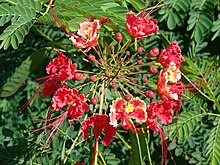|
Caesalpinia
Caesalpinia is a genus of flowering plants in the family Fabaceae. It includes 10 species which range from southeastern Mexico through Central America to Colombia, Ecuador, and Peru, and to Cuba, Hispaniola, and the Bahamas.[1] Historically, membership within the genus has been highly variable, with different publications including anywhere from 70 to 165 species, depending largely on the inclusion or exclusion of species alternately listed under genera such as Hoffmannseggia. It contains tropical or subtropical woody plants. The generic name honours the botanist, physician, and philosopher Andrea Cesalpino (1519–1603).[3] The name Caesalpiniaceae at family level, or Caesalpinioideae at the level of subfamily, is based on this generic name. Species10 species are currently accepted:[1]
UsesSome species are grown for their ornamental flowers. References
External links
|
||||||||||||||||||||||||||||||||||||||||
